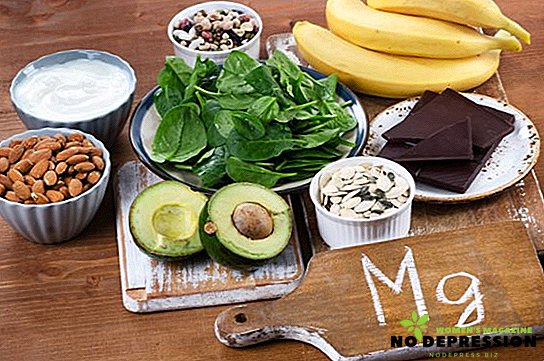One of the most important minerals in the human body is magnesium. Physiologists put this element in third place on the value for health after oxygen and water.
It is required to activate more than 300 biochemical reactions that trigger the proper functioning of vital systems and organs. It is all the more surprising that most people are not aware of this and do not include magnesium-containing products in their daily diet.

Below you will find out where magnesium is contained, in which particular products its content is most, but first we will talk about the benefits of this element.
Why we can not do without magnesium
The main tasks of this valuable macro element are the regulation of cardiovascular activity, control of blood glucose levels, ensuring the conduction of impulses for muscle and nervous activity, participation in protein synthesis and energy metabolism.
A sufficient level of magnesium gives the body the following benefits:
- maintains a stable heart rhythm;
- helps prevent heart attacks, hypertension, blood clots, strokes, heart attacks;

- provides bone health, including minimizes the risk of osteoporosis;
- optimizes blood sugar levels;
- eliminates constipation;
- increases cellular energy and prevents chronic fatigue syndrome;
- removes painful manifestations of neuralgia and muscular character;
- contributes to the treatment of depression, panic attacks, anxiety disorders;
- improves sleep quality;
- improves the absorption of other minerals (potassium, calcium, sodium).
There is evidence that magnesium prevents the appearance of kidney stones, but one must be careful with its consumption if the stones have already formed. And also reduces the severity of manifestations of premenstrual syndrome (reduces tension, irritability, chest pain).
How much magnesium is required per person daily
Regular need for magnesium varies in an adult between 310 and 420 mg per day, but in any case it is not recommended to exceed the dose of 500 mg. For men, this indicator for life is 400-420 mg, for women 310-320 mg.
 Infants receive the required amount from their mother’s milk: in the first months of life, the child needs 30 mg daily, by 1 year - 75 mg. A preschool child needs 130 mg per day.
Infants receive the required amount from their mother’s milk: in the first months of life, the child needs 30 mg daily, by 1 year - 75 mg. A preschool child needs 130 mg per day.
Periods of active growth of the body, hormonal changes or increased nerve and physical exertion require enhanced magnesium nutrition. So it needs teenagers, the elderly, pregnant women, nursing mothers, athletes (especially involved in strength sports).
Some physical conditions also require an increase in daily intake of magnesium. These include:
- Any dehydration (vomiting, diarrhea, diuretic drugs).
- Frequent use of alcohol (alcohol reduces the body's ability to absorb nutrients from food).
- Increased blood glucose levels.
- Renal diseases (with the last two disorders, there is a loss of magnesium through the excretory system).
What causes magnesium deficiency
Nature has taken care to ensure that the magnesium obtained from food is preserved and reasonably consumed by the body, therefore the activity of the kidneys regulates the excretion of this mineral. But sometimes temporary situations arise when, due to the restriction of the diet, the intake of certain drugs, painful conditions, the body either does not accumulate a sufficient amount of the macroelement, or quickly loses it.
 In this case, the first signs of magnesium deficiency appear in the form of lethargy, nausea, loss of appetite. They may be joined by numbness in the muscles, convulsions, an irregular heartbeat, vascular spasms. As a rule, with the elimination of the underlying cause, unpleasant symptoms disappear.
In this case, the first signs of magnesium deficiency appear in the form of lethargy, nausea, loss of appetite. They may be joined by numbness in the muscles, convulsions, an irregular heartbeat, vascular spasms. As a rule, with the elimination of the underlying cause, unpleasant symptoms disappear.
The second type of deficiency is the reaction of the internal organs to a permanent lack of magnesium (the so-called habitually low consumption). Providing changes at the level of biochemistry, such a shortage over time can cause great harm, destroying the heart, bones, nervous and hormonal systems.
Especially dangerous diseases are cardiovascular pathologies (among them - hypertension, arrhythmias, stroke), type II diabetes (with preservation of the ability of the pancreas to produce insulin, but a violation of its digestibility due to damage to cellular receptors), osteoporosis and migraine.
Doctors also point to the direct connection of magnesium deficiency with the occurrence of asthma and the development of depression.
What foods are rich in magnesium
The good news is that magnesium is widely distributed in plant and animal products, which means its sources are available for daily consumption.
Plant Food
What plant foods do you have the most magnesium in? The top three here are green leafy vegetables, whole grains and legumes:
- cereals and products from them - unpolished rice, wheat, oats, barley, rye bread, pita bread, bran, cereals;
- legumes - beans, peas, lentils, soybeans;
- fresh vegetables (especially dark green) - spinach, parsley, cucumber, zucchini, celery, all kinds of cabbage, potatoes, beets, sweet peppers, pumpkins;
- fruits and dried fruits - avocado, kiwi, bananas, currants, cherries, watermelons, figs, prunes, raisins;
- nuts and seeds - cashews, peanuts, unrefined almonds, pistachios, sesame seeds, pumpkin seeds and sunflower seeds.

Animal Food
What animal products contain a lot of magnesium? From this group, special attention should be paid to sea and river fish, as well as the whole range of dairy products, except butter (there is very little magnesium in it):
- fish - salmon, tuna, mackerel, cod, carp, sardines in oil, caviar;
- seafood - squid, shrimp, oysters, crab sticks (surimi);
- milk - any (cow, goat, sheep), condensed milk, powdered milk;
- dairy products - especially cheeses and natural yoghurt;
- meat - beef, lamb, chicken (red meat), pork, ham;
- the eggs.
Bottled mineral water is also a source of magnesium. Depending on the type of water, its amount varies from 1 g / l to 120 g / l (the exact number is indicated on the label).

How to calculate daily magnesium need
Below is a table of some common products, based on which you can make a rough menu with the required standards.
| Separate food sources | The amount of magnesium (mg) | Percent from daily rate |
|---|---|---|
| Unrefined almonds roasted, 30 g | 80 | 20 |
| Boiled spinach, ½ cup | 78 | 20 |
| Wheat wholegrain bread, 2 pieces | 61 | 15 |
| Boiled beans, 1 cup | 61 | 15 |
| Peanut butter, 2 tablespoons | 49 | 12 |
| Avocado, diced, 1 cup | 44 | 11 |
| Baked potato with peel, 100 g | 43 | 11 |
| Brown rice, ½ cup | 42 | 11 |
| Natural low fat yogurt, 250 g | 42 | 11 |
| Instant Cooking Oatmeal, 1 Pack | 36 | 9 |
| Banana, 1 piece | 32 | 8 |
| Baked salmon, 100 g | 26 | 7 |
| Milk, 1 cup | 24-27 | 6-7 |
| Raisin, ½ cup | 23 | 6 |
| Fried chicken breast, 100 g | 22 | 6 |
| Boiled beef, 100 g | 20 | 5 |
| Broccoli boiled and sliced, ½ cup | 12 | 3 |
| Apple, 1 piece | 9 | 2 |
| Raw carrots, 1 piece | 7 | 2 |
Potassium, calcium, selenium, magnesium - how to get "four in one"
It is important that the majority of the listed products allows to saturate the body not only with magnesium, but also with other irreplaceable components: macrocells with potassium and calcium and trace elements with selenium.
Therefore, choosing the whole grain cereals, legumes, dairy products, fish, vegetables and nuts as the basis for the ration, you can get a universal menu that is rich in all the minerals listed at the same time. Special attention should be paid to hard and soft cheeses, avocados, spinach, lentils, soybeans, salmon, almonds, dried apricots, wheat germinated grains, seaweed.
What threatens the excess of magnesium
The risk of getting excessive amounts of magnesium from food in a healthy person is almost zero, since the process of accumulation and elimination of this mineral is controlled by the kidneys. But if you take it as an additive, then the danger of harming the body increases.
 In uncontrolled quantities, medicinal magnesium becomes toxic. Its high doses can cause diarrhea, accompanied by nausea and spastic pain.
In uncontrolled quantities, medicinal magnesium becomes toxic. Its high doses can cause diarrhea, accompanied by nausea and spastic pain.
Mental retardation, muscle weakness, breathing problems may also occur. A tenfold excess of the daily limit (i.e., 5,000 mg intake) is considered critical.
Caution should be taken such drugs renal patients, as well as those who are undergoing a course of antibiotics - magnesium blocks the action of the latter.
If it is decided to introduce magnesium in the form of an additive, then it must be combined with calcium: these two elements improve each other's performance.
Conclusion
Without magnesium, correct functioning of the heart, musculoskeletal system, hormones and nervous system is impossible.
 For well-being, an adult organism needs from 310 to 420 mg of this macrocell per day. This amount can be fully covered only by food.
For well-being, an adult organism needs from 310 to 420 mg of this macrocell per day. This amount can be fully covered only by food.
The best food sources of healthy mineral are nuts, cereals, dark green vegetables, beans, dairy products.
Regular magnesium deficiency causes 4 major diseases: hypertension, osteoporosis, type II diabetes, migraine.
The excess of magnesium through food is almost impossible, and in dosage forms it can cause gastrointestinal disturbances and depression of the nervous system.
More information about magnesium can be found in the following video.













